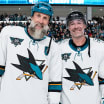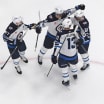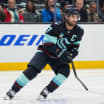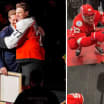MANALAPAN, Fla. -- Lou Lamoriello did not know or care that the New York Islanders' decision to acquire Bo Horvat from the Vancouver Canucks on Jan. 30 would lead to a flurry of activity well in advance of the 2023 NHL Trade Deadline.
NHL GMs say early deals before NHL Trade Deadline could be trend
Salary cap relief for injured players, 3rd teams as brokers help facilitate moves
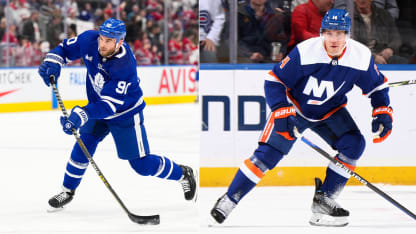
"We knew he was available, and I think if you can get ahead of the situation as far as getting something done as soon as possible, if that's something you're interested in, then what are you going to wait for?" Lamoriello, the Islanders general manager, said at the GMs meetings this week.
New York's deal for Horvat was the first of 45 trades involving 90 players and 61 draft picks from Jan. 30-March 2. There were another 21 trades involving 34 players and 14 draft picks March 3, deadline day.
Though it's too soon to say with certainty, many general managers believe the action in the weeks before deadline day this year could become the norm.
"It might be trending that way," San Jose Sharks GM Mike Grier said. "That's what happens in some of the other sports as well, especially if you're a buyer. It makes sense to get your players in earlier to help integrate them and get them adjusted to their new surroundings. Maybe you also get a guy earlier than the market dictates. I think that's where it's trending. It makes for a long trade deadline, but deadline day itself is a little anticlimactic."
There are a variety of theories as to why the trade season started early this season and stayed frantic with top players like forwards Horvat, Vladimir Tarasenko, Patrick Kane, Timo Meier and Ryan O'Reilly all moving from Western Conference to Eastern Conference teams.
Most notably, the NHL salary cap has been a factor in deterring teams from conducting their business early in previous seasons because the longer a team waits, the more cap space it accrues based on the accounting of the cap.
But Tampa Bay Lightning general manager Julien BriseBois cited the fact that about half of the League was using the long-term injured reserve (LTIR) relief money, meaning they had a fixed amount of cap space available that was not going to change.
When a team has players on long-term injured reserve, particularly players they know will not return this season, they can exceed the upper limit of the salary cap by the amount of cap space they have for LTIR.
With more teams using the LTIR relief money, it opened the door for those teams to act earlier in the trade season because they did not have to worry about accruing more cap space daily.
"All the teams in LTI, it doesn't apply to us. You're not accruing any cap space," BriseBois said. "You know what you have."
Many of those teams are in a Stanley Cup Playoff position, including the Lightning, Toronto Maple Leafs, Vegas Golden Knights, Boston Bruins and New Jersey Devils, who all made significant moves before deadline day.
BriseBois said the LTIR cap relief has become more of a factor since the NHL had to go to a flat cap starting with the 2020-21 season, a result of revenues lost during the COVID-19 pandemic.
The salary cap was $81.5 million from 2019-21. It went up to $82.5 million this season. It is projected to go up to $83.5 million next season with the possibility of a larger jump depending on hockey-related revenue.
"I think the flat cap has forced us to become really well versed in how to use LTI," BriseBois said. "There used to be very few teams in LTI in the first few years of the cap world. Everyone would usually try to keep more of a cushion. No one would go right up to the cap. But now so many teams are right up against the cap because once you're in LTI you might as well be. Take full advantage of it."
Teams will adjust when the cap does make that larger jump -- it is expected to go up by about $4.5 million either next season or for 2024-25 -- but those teams that spend to the cap will likely still do so, which would then still make LTIR a factor for some.
"You build your projections knowing that," BriseBois said.
Deals brokered with a third party were also popular this year, aiding the ability for teams that operate near the cap or in LTIR to make trades.
There were four that involved a third team entering the deal and getting a small compensation for retaining salary, allowing the team that was buying to get the player it wanted at a more favorable cap charge.
"There were more teams willing to be a third party and to participate," Lamoriello said.
The Arizona Coyotes were the third party in the trade that ultimately sent Kane from the Chicago Blackhawks to the New York Rangers.
The Minnesota Wild filled that role in the trades that sent O'Reilly from the St. Louis Blues to the Maple Leafs, and defenseman Dmitry Orlov and forward Garnet Hathaway from the Washington Capitals to the Bruins.
The Montreal Canadiens were the third party that helped forward Nick Bonino go from the Sharks to the Pittsburgh Penguins.
"With the flat cap, squeezing every nickel out of everywhere becomes a priority," Golden Knights GM Kelly McCrimmon said.
Parity, competition and a sense of realism are other factors that led to teams looking to get deals done early and could do so in the future.
The parity in the NHL has led to more teams believing they have a chance to win the Stanley Cup, creating aggressive buyers who want to act early to get the players they're targeting.
There were also teams like the Blues and Capitals that recognized, even though they weren't out of the playoff race, that they weren't going to be Cup contenders this season, so they were willing to move significant players on expiring contracts.
Both had multiple players in that category: O'Reilly, Tarasenko, forwards Noel Acciari and Ivan Barbashev, and defenseman Niko Mikkola for St. Louis; and Hathaway, Orlov and forwards Lars Eller and Marcus Johansson for Washington.
All were traded.
"There are fewer and fewer teams comfortable being in the middle and there's a number of teams having a really good season and feel like this is a good chance for them to try to win a Cup and they're willing to invest," BriseBois said. "There are some teams that have clearly stated that they need to add draft capital to build a championship program over a number of years."
None of that is expected to change in the future, which leads to the speculation that what transpired this season will happen again.
"I wouldn't be surprised if this trend continues," Carolina Hurricanes GM Don Waddell said. "It's going to be measured on team success, how it works out. It all made sense why it happened this way this year, but it was sooner than years prior, that's for sure."


